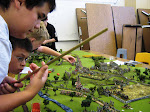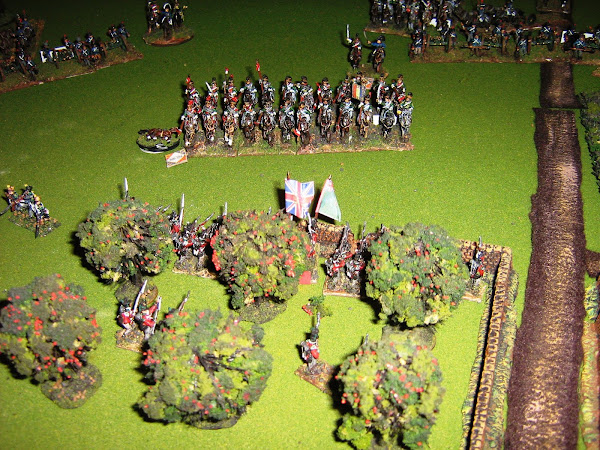Thursday, December 11, 2025
More Perry 28mm Austrians For Sale
I have two regiments of landwehr for sale, each of 24 figures, the Lower Austrian Landwehr (gray coats) and the Salzburg Landwehr (green coats) $65 per regiment plus $10 shipping within the Continental US or both units for $120 plus $10 shipping within the Continental US.
Friday, December 5, 2025
28 mm Perry Plastic Austrians for Sale
I have 72 painted Perry plastic Austrians for sale. 24 are in shako, 48 in helmet.
$150 plus $10.00 shipping to CONTUSA
Wednesday, December 3, 2025
Rising of the Clans After Action Report
It had been quite awhile since I had a battle with my Rising of the Clans rules. I have painted up a village and used that as the center piece for the right flank of the Government forces. The scenario charged a Jacobite force to cut a road that the Government hope to use to move supplies over. Four brigades of the King's men were given the task of holding the road, allowing the desperately needed supplies to get to their destination.
Turn 1- The story of turn one was the highly effective fire of the Jacobite artillery. Mortars and cannon pounded the Government line causing casualties and disorder.
Roy Stewart is able to push his largest regiment, the Camerons of Locheil, across the river.
Turn 2- Drummond pushed his clans into an orchard. His command rolls were poor so little progress was made. One unit formed line and fired a volley, but the targeted Government regiment was protected behind a stone wall and didn't lose a man.
Colonel Stapleton marched his two elite regiments of French regulars across a bridge into a postion to apply pressure on the Government center. Legonier, commanding the Govrenment cavalry, split his command, sending two regiments under the ADC to counter Stewart's men coming across the bridge.
The Yorkshire Blues suffer more casulaties from Olgilvy's heavy guns.
Turn 3- Drummond and Cholmondeley's men exchange ineffective volleys. However, Drummond's mortars continue to batter the line, this time hitting Cholomondeley's battery.
The order in which cards are drawn can be telling. It certainly was on this turn. Stapleton's card came up and his command rolls allowed both of his regiments to form line and fire into the Government line. The carnage was terrible.
Roy Stewart was also fortunate to have his card drawn before Campbell of Montrose. His own regiment charged down the road and caught the Edinburgh Militia in a march column forcing them back into the village in great disorder. The 10th Dragoons, however, were able to countercharge later in the turn and bring the highlanders to a halt, disordering both units.
Finally, the Yorkshire Blues suffer yet another casualty and are close to breaking.
Turn 4- Drummond is finally able to launch an attack on the stone wall. While he is able to drive back two of Cholmondeley's regiments, the victory is not decisive and he loses many good men in the effort.
In the center, Wolf is able to bring fire to bear on Stapleton's Frenchmen, thinning their ranks. He suffers a setback, however, when musketry from the Atholl Brigade routs his artillery battery from the field.
On the Government right an untimely lull ocurrs in the action as all three commanders in that sector fail their command rolls.
An overview of the action in the center.
Turn 5- This turn Drummond presses his attack. Three clans clammer over the stone wall and continue to drive back the regiment facing them. Once again, it is not a decisive victory to Drummond's great dismay.
In the center, Wolf's veteran 4th Foot puts up a stout defense against the Atholl men and Stapleton's two regiments have been shredded by intense musketry. All would be looking good for Wolf except for the fact the 47th Foot, holding the right of line his line, is destroyed by the Cameron's of Locheil. The momentum of their charge is halted by a timely countercharge of the 14th Dragoons. Despite this, the situation is precarious.
Things remain fairly static on the Government right, mainly due to the inaction of Lord Olgilvy. The only newsworthy even in this region is the destruction of the Yorkshie Blues after yet another blast of cannon. By all accounts, Campbell of Montrose was rather derilect in keeping them in an exposed position for no real purpose.
Turn 6- Cholmondeley's card is drawn first. His men are only able to issue a couple of volleys with mixed results. Clan Macranald is driven from the field, but will it be enough to blunt the blow that is sure to come this turn?
Disaster strikes the Jacobite cause when Drummond tosses an "11" for his command roll. His men will remain idle for this turn. The opportunity to roll up the Government flank is quickly eluding him.
Things also go badly for the Bonnie Prince in the center. Stapleton, desperately needing to withdraw his men, rolls an "11" as well. His men will have to withstand yet more musketry without being able to respond.
General Hawley does not let this opportunity pass him by. He orders Legonier's dragoons and Wolf's 4th Foot to charge. The Atholl men are driven back and disordered. Wolf moves his reserve regiment to secure his right flank.
The dragoons under the command of the ADC sacrifice themselves by charging Roy Stewart's men. Their heroism pays off as Stewart's attack is stalled. Will it be enough?
In yet another brutal setback to the Jacobites, the ADC trying to bring up the last of the reserves to secure the victory rolls an "11". Two veteran clans will remain on the other side of the river.
Olgilvy finally presses his men across the river towards the village. In turn seven there are sure to be fireworks on this flank.
Subscribe to:
Comments (Atom)




























































